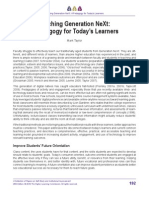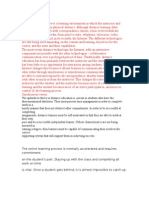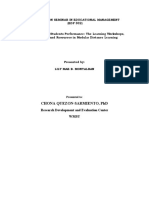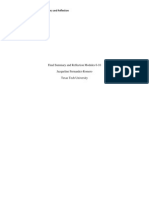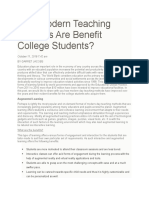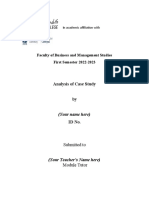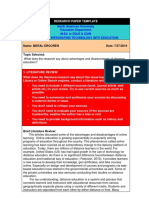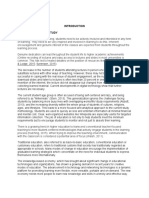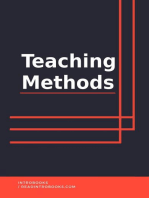0 ratings0% found this document useful (0 votes)
59 viewsCasestudy
Casestudy
Uploaded by
api-265557783Copyright:
© All Rights Reserved
Available Formats
Download as DOCX, PDF, TXT or read online from Scribd
Casestudy
Casestudy
Uploaded by
api-2655577830 ratings0% found this document useful (0 votes)
59 views6 pagesOriginal Title
casestudy
Copyright
© © All Rights Reserved
Available Formats
DOCX, PDF, TXT or read online from Scribd
Share this document
Did you find this document useful?
Is this content inappropriate?
Copyright:
© All Rights Reserved
Available Formats
Download as DOCX, PDF, TXT or read online from Scribd
Download as docx, pdf, or txt
0 ratings0% found this document useful (0 votes)
59 views6 pagesCasestudy
Casestudy
Uploaded by
api-265557783Copyright:
© All Rights Reserved
Available Formats
Download as DOCX, PDF, TXT or read online from Scribd
Download as docx, pdf, or txt
You are on page 1of 6
Running Head: TRACEY NIRLDON CASE STUDY
A Student Perspective of Online Courses: Tracey Nirldon Case Study
Paul R. Munshower Jr.
Texas Tech University
TRACEY NIRLDON CASE STUDY 2
A Student Perspective of Online Courses: Tracey Nirldon Case Study
Students taking online courses for the first time are going to face challenges in spite of
their familiarity with the content covered by the course. Online courses can be a disadvantage to
students, as they not only present learners with new and difficult materials, but also a new and
challenging learning environment. Distance education has evolved quickly over the last decade
and instructors are better equipped and trained to teach in an online environment (Simonson,
2012). With the popularity and demand of distance education, many current online teachers have
years of experience meaning their courses and content have been revised to meet the needs of
their students. This case study will address strategies for success from both the student and
teacher perspective.
Tracey Nirldon is enrolled in the online course Introduction to Teaching. An online
course can be a stressful experience as the expectations established by online instructors are
often different than those found in traditional classrooms. Key to the online experience is for
students to have a clear understanding of exactly what is required for successful participation in
the correct manner according to the online educational community (Simonson, 2012). While the
content is similar, the method of delivery will be diverse. All students must reflect on their
preparedness for an online course and its delivery format. Students will be expected to possess or
acquire technical skills that traditional students may otherwise not be expected to have.
Many tools are accessible to aide students, like Tracey, in ascertaining their readiness for
online courses. SmarterMeasure is a tool that will enable students to evaluate their level of
preparedness for distance education courses (SmarterMeasure, 2013). Students should genuinely
self-assess to confirm they are prepared for an online course.
TRACEY NIRLDON CASE STUDY 3
Student must have regular access to the technology and skills required for the course,
whether at home, through friends and family, school, or public resources. They should also have
an established backup plan if their primary source of technology access becomes unavailable.
Tracey, like all students, must have basic understanding of the course management system and
will need to look for institution workshops for that system or self-paced tutorials to acquire the
necessary skills and knowledge for the course management system.
Many resources are available for students that provide strategies for online learning.
Tracey, and other students, should employ success strategies such as establishing a regular
learning schedule, joining study groups, and asking questions to increase her chances for success,
among others, which can be found at the 7 Success Strategies For Distance Learners (2013).
Nobody has a better understanding of their schedule than the student themselves.
Therefore, students should determine the best time in their schedule to study effectively (Roper,
2007). Tracey must identify times in her daily routine that are not available and dedicate times
for coursework, as time management may be the single biggest factor in succeeding at your
online course (Gatlin, 2013).
In an online environment, students may feel isolated. Therefore, students should actively
seek mentors or other students in similar courses. Students should also search for study groups,
possibly via social media and other online resources.
Online students often describe a deficiency in communication with their teachers. In an
online course there is an unstated expectation of communication, and this responsibility falls on
both the learner and instructor. It is imperative that Tracey, like all students, takes advantage of
the variety of communication methods available such as email, phone calls, text messaging,
and/or course messaging to ask clarifying questions. Students must also take into consideration
TRACEY NIRLDON CASE STUDY 4
the strengths and weaknesses of these communications. While asynchronous communication
allows an individual to communicate anytime, there is often a lag between question and answer,
therefore, students cannot wait until the last minute to ask questions or the answer will not be
helpful.
An effective online instructor is aware of their student population and effective online
instructional strategies available to them. Online students will have different demographics than
traditional students. In order for students to have an equivalent learning experience, online
instructors must provide additional focus on communication, organization, and help resources for
online learners (Simonson, 2012).
While online students have many traits similar to traditional students, differences exist
and must be considered when planning and designing online instruction (Simonson, 2012). Not
only do online students tend to be older, self-motivated, married with dependents, and are
usually employed full-time (Characteristics of Distance Learning Students, 2007), but they will
also be diverse in culture, tradition, learning styles, educational levels, and educational needs.
Online courses must be organized to proved easy access to course materials and not leave
students lost and searching. Course menus must give a natural feel for navigation. Course content
should be logically organized into units, modules, and topics (Simonson, 2012).
Online instructors must not only provide but also encourage students to use multiple
methods of communication. Much of the communication will be asynchronous, but the instructor
must provide timely feedback to the learners in order to be effective. Instructors must offer
motivational strategies to dissuade procrastination and provide time management tools. Help
resources should also be provided for students. Students need quick access to course syllabus,
TRACEY NIRLDON CASE STUDY 5
assignment schedules, contact information, and help resources relevant to the course
management system.
I currently teach high school physics using a blended classroom approach. The
instruction is flipped and accessed by the students at home online while class time is used to
reinforce and enrich content through labs, PBL, and activities. It was a learning curve for both
the students and myself. My students were definitely not prepared for this approach because they
were conditioned and used to the traditional lecture style approach. While they struggled in the
beginning, they are now buying into the instructional approach and experiencing success.
Throughout the course I have had students reflect on their experiences so that I can constantly
evaluate and revise the course content. Video content, layout, and length are some things that I
am constantly changing to meet my students needs so that their learning is equivalent to the
other students in similar courses.
Advances in technology and software, along with a broader acceptance of distance
education, has allowed for many programs to emerge and be offered either partially or entirely
online. This provides opportunities for many untraditional students that would otherwise be
unable to pursue further education, like myself. Without distance education, I would be unable to
pursue a doctorate.
References:
7 Success Strategies for Distance Learners. (2013). Retrieved, October 28, 2014, from
http://www.worldwidelearn.com/education-articles/distance-learning-success.htm.
Characteristics of Distance Learning Students. (2007). Retrieved, October 28, 2014, from
http://www.wpi.edu/Academics/ATC/Collaboratory/Teaching/students.html.
TRACEY NIRLDON CASE STUDY 6
Gatlin, S. (2013). How to succeed as an online student. Retrieved, October 28, 2014, from
http://distancelearn.about.com/od/distancelearning101/a/studentsuccess.htm.
Roper, A. (2007). How Students Develop Online Learning Skills. EDUCAUSE Quarterly,
30(1), 62-65.
Simonson, M., Smaldino, S., Albright, M., & Zvacek, S. (2012). Teaching and Learning at a
Distance. Boston, MA: Pearson.
SmarterMeasure. (2013). Retrieved, October 28, 2014, from http://www.smartermeasure.com
You might also like
- Graphic Designer Performance Appraisal FormDocument3 pagesGraphic Designer Performance Appraisal FormRegina C. Acopiado67% (6)
- Teacher Leadership SurveyDocument2 pagesTeacher Leadership SurveyTyler83% (18)
- Sample Work Plan in MathDocument6 pagesSample Work Plan in Mathhilda garcia100% (4)
- Teaching GNDocument5 pagesTeaching GNnaaneninnaNo ratings yet
- ConclusionDocument7 pagesConclusionEng Jye NgNo ratings yet
- 302 Paper MaeDocument26 pages302 Paper MaePhantom ThiefNo ratings yet
- GRADE 12 THESIS Vanessa MacabatalDocument16 pagesGRADE 12 THESIS Vanessa Macabataljack macabatalNo ratings yet
- Grade 12 Thesis VanessaDocument16 pagesGrade 12 Thesis Vanessajack macabatalNo ratings yet
- Artikel Jurnal 85%Document14 pagesArtikel Jurnal 85%Widya Nur AfiatiNo ratings yet
- GRADE - 12 - THESIS - Vanessa MacabatalDocument17 pagesGRADE - 12 - THESIS - Vanessa Macabataljack macabatalNo ratings yet
- Final Summary and Reflection Modules 6-10Document8 pagesFinal Summary and Reflection Modules 6-10api-264575628No ratings yet
- What Is Remote LearningDocument8 pagesWhat Is Remote LearningKevin LOZANO RAMIREZNo ratings yet
- PatrickDocument14 pagesPatrickSantino AdmanaNo ratings yet
- EDUC 31 Unit 4 Lesson 9 Instructional Delivery Modalities FinalDocument11 pagesEDUC 31 Unit 4 Lesson 9 Instructional Delivery Modalities FinalMyrenne Mae BartolomeNo ratings yet
- VentenDocument3 pagesVentenJigen HermosaNo ratings yet
- Face To Face Learning and Distance LearnDocument10 pagesFace To Face Learning and Distance Learnjeremy pontillasNo ratings yet
- Kearl O. Mandao RSDocument24 pagesKearl O. Mandao RSKearl MandaoNo ratings yet
- Distance LearningDocument10 pagesDistance LearningAwgNaziroolFxNo ratings yet
- Gracelyn ResearchpaperDocument30 pagesGracelyn ResearchpapercrisdayNo ratings yet
- DISTANCE EDUCATION: THE NEW TENDENCIES IN THE DOMAIN OF FOREIGN LANGUAGE LEARNING WITH SPECIAL REFERENCE TO FRENCH LANGUAGEnvita ShrivastavDocument14 pagesDISTANCE EDUCATION: THE NEW TENDENCIES IN THE DOMAIN OF FOREIGN LANGUAGE LEARNING WITH SPECIAL REFERENCE TO FRENCH LANGUAGEnvita ShrivastavAnonymous CwJeBCAXpNo ratings yet
- ResearchDocument4 pagesResearchLubeth CabatuNo ratings yet
- Blended Learning: Challenges For Learners andDocument7 pagesBlended Learning: Challenges For Learners andREEcNo ratings yet
- A Comparative Analysis On The Behaviour of Students Before and NowDocument9 pagesA Comparative Analysis On The Behaviour of Students Before and NowMa. Christina BusaingNo ratings yet
- Emerging Issues in Online Support OMDE610 Stephanie MartinDocument10 pagesEmerging Issues in Online Support OMDE610 Stephanie MartinstephleediverNo ratings yet
- Research 1-Blended Learning ApproachesDocument6 pagesResearch 1-Blended Learning Approachesmarlene parzaNo ratings yet
- Name: Year: Subject: Assessment Ii Date: Instructor/Professor: MR. ROMEO REDULLADocument3 pagesName: Year: Subject: Assessment Ii Date: Instructor/Professor: MR. ROMEO REDULLANormina CagunanNo ratings yet
- Challenges: of Remote Learning For Offline LearnersDocument18 pagesChallenges: of Remote Learning For Offline LearnersIrene SabidNo ratings yet
- Action Research Proposal SampleDocument14 pagesAction Research Proposal SampleraquelNo ratings yet
- Models/Forms/Types of Virtual Schools: EDTC 650: Assignment # 1Document11 pagesModels/Forms/Types of Virtual Schools: EDTC 650: Assignment # 1alangleynewton8710No ratings yet
- Parents Participation Towards The Modular Learning To Grade 11 Students of IACCESS S.Y. 2020-2021Document13 pagesParents Participation Towards The Modular Learning To Grade 11 Students of IACCESS S.Y. 2020-2021Nova Perez CorderoNo ratings yet
- Week 2 DebateDocument6 pagesWeek 2 Debateapi-215386653No ratings yet
- Omde 608 Assignment 3 - DavisDocument8 pagesOmde 608 Assignment 3 - Davisapi-298237027No ratings yet
- Distance Learning and Effect On Practical Skills Courses in BTVTED of ZCSPCDocument12 pagesDistance Learning and Effect On Practical Skills Courses in BTVTED of ZCSPCMae CherryNo ratings yet
- Case Analysis - Module 7Document5 pagesCase Analysis - Module 7api-264693867No ratings yet
- Chapter One, Two, Three - Arazan1111Document28 pagesChapter One, Two, Three - Arazan1111Lindsymae Sula-sula100% (1)
- Chapter One, Two, Three - Arazan1111Document28 pagesChapter One, Two, Three - Arazan1111Lindsymae Sula-sula100% (1)
- Distance Learning Historical PaperDocument11 pagesDistance Learning Historical PaperTerry PriahNo ratings yet
- How Modern Teaching Methods Are Benefit College Students?: October 11, 2018 7:42 AmDocument3 pagesHow Modern Teaching Methods Are Benefit College Students?: October 11, 2018 7:42 AmihlaNo ratings yet
- 1 of 5 17TH Annual Conference On Distance Teaching and LearningDocument5 pages1 of 5 17TH Annual Conference On Distance Teaching and Learningapi-295665506No ratings yet
- The Problem and Its SettingDocument28 pagesThe Problem and Its SettingRamel PaglanganNo ratings yet
- TLP Group 3 Carol Pham Lania Moreno Maria Elena Venegas Phase1Document9 pagesTLP Group 3 Carol Pham Lania Moreno Maria Elena Venegas Phase1api-535294929No ratings yet
- 10 Literature Review (Apurva, Rani)Document30 pages10 Literature Review (Apurva, Rani)apurva kadamNo ratings yet
- Eds3701 Assignment 2 2023Document5 pagesEds3701 Assignment 2 2023mangalamacdonaldNo ratings yet
- Online Learning vs. Classroom InstructionDocument5 pagesOnline Learning vs. Classroom InstructionDonato Julie DianneNo ratings yet
- The Impact of Emerging Trends/ Polices in EducationDocument26 pagesThe Impact of Emerging Trends/ Polices in EducationZankhana VithlaniNo ratings yet
- Assignment Hmef5083 RosazaliDocument16 pagesAssignment Hmef5083 Rosazalirimr1980No ratings yet
- Chapter 1Document7 pagesChapter 1CJNo ratings yet
- Learning and Teaching Strategies Preferences of Btled Students During The New Normal of EducationDocument26 pagesLearning and Teaching Strategies Preferences of Btled Students During The New Normal of EducationKen Dela ChinaNo ratings yet
- Distribution and Collection of Modules: An Evaluative ResearchDocument19 pagesDistribution and Collection of Modules: An Evaluative ResearchJerame M ColanoNo ratings yet
- Kindly Work On Your Assigned Area of The Syllabus For Purposive CommDocument6 pagesKindly Work On Your Assigned Area of The Syllabus For Purposive CommNeo ArtajoNo ratings yet
- 21st Century Learning - Distance LearningDocument6 pages21st Century Learning - Distance LearningPaulineBorjaMirandaNo ratings yet
- Teaching MethodDocument6 pagesTeaching MethodFe Annalie SacalNo ratings yet
- Barriers of Blended LearningDocument7 pagesBarriers of Blended LearningSamreenNo ratings yet
- Research Group 5Document4 pagesResearch Group 5Jaynah TolentinoNo ratings yet
- Educ 5324-Research Paper - Meral ErgorenDocument4 pagesEduc 5324-Research Paper - Meral Ergorenapi-459726606No ratings yet
- MethodolgyDocument6 pagesMethodolgyPerla KfouryNo ratings yet
- Argumentative EssayDocument2 pagesArgumentative EssayJoyceNo ratings yet
- EA02 1st Batch 2nd Sem AY2022 2023Document3 pagesEA02 1st Batch 2nd Sem AY2022 2023Aira Dela CruzNo ratings yet
- Blended & Reflective LearningDocument11 pagesBlended & Reflective LearningmarideloritNo ratings yet
- Autonomy & Motivation in Distance Learning: Robert・CVITKOVIC, Yoshie SakamotoDocument0 pagesAutonomy & Motivation in Distance Learning: Robert・CVITKOVIC, Yoshie SakamotoDumitriţa ChiricaNo ratings yet
- Background of The StudyDocument6 pagesBackground of The StudyRex Emmanuel IntalNo ratings yet
- Collaboration in Blended Learning Focus in The New Normal EducationDocument13 pagesCollaboration in Blended Learning Focus in The New Normal EducationAnn Louise De LeonNo ratings yet
- Pfa - Applied PfaDocument85 pagesPfa - Applied PfaEl Comedor BenedictNo ratings yet
- #6 - Analyzing Consumer Markets: Marketing ManagementDocument12 pages#6 - Analyzing Consumer Markets: Marketing ManagementShin LuvKiEnNo ratings yet
- Form 3Document7 pagesForm 3api-30389426No ratings yet
- CAS Reflection GuidelinesDocument4 pagesCAS Reflection GuidelinesKevin HomNo ratings yet
- Bibliotherapy - A Review and Analysis of The Literature by Lenkowsky (1987)Document11 pagesBibliotherapy - A Review and Analysis of The Literature by Lenkowsky (1987)Fourani HASPNo ratings yet
- Syllabus Assesment of LearningDocument10 pagesSyllabus Assesment of LearningMargen CagoNo ratings yet
- Tesfamichael Mulugeta (Sgs-0049-2009a Paper ResearchDocument69 pagesTesfamichael Mulugeta (Sgs-0049-2009a Paper ResearchLweli LupondoNo ratings yet
- TP Task 2Document3 pagesTP Task 2api-307404330No ratings yet
- Error Correction 2Document24 pagesError Correction 2BAGASKARANo ratings yet
- Eudaimonic WellbeingDocument13 pagesEudaimonic WellbeingJulianna NicoleNo ratings yet
- Teaching SpeakingDocument7 pagesTeaching Speakingika dewiNo ratings yet
- Nebosh Hse Certificate in Health and Safety Leadership ExcellenceDocument10 pagesNebosh Hse Certificate in Health and Safety Leadership ExcellenceNguyen Van Thanh100% (1)
- Sharpen The SawDocument2 pagesSharpen The SawNickyjohn LarozaNo ratings yet
- Dark TriadeDocument31 pagesDark Triadefabio patonNo ratings yet
- Creating Effective TeamsDocument33 pagesCreating Effective TeamsVali Ostafi100% (1)
- Unit 1 Different Concept of TechnologyDocument7 pagesUnit 1 Different Concept of TechnologyAVEGAIL SALUDONo ratings yet
- Micro Teaching #3 Lesson PlanDocument2 pagesMicro Teaching #3 Lesson Planbobbymaf7No ratings yet
- Clinical Teaching MethodDocument12 pagesClinical Teaching MethodMaricris Tac-an Calising-Pallar100% (1)
- Makato and The Cowrie ShellDocument5 pagesMakato and The Cowrie ShellBel DeJesus100% (2)
- 5P ModelDocument2 pages5P ModelShella AzizahNo ratings yet
- Gatiawin High School: En8Rc - Ie-7 En8Vc - Ie-9 En8V - Ie-4 En8Lt - Ie-2.2Document4 pagesGatiawin High School: En8Rc - Ie-7 En8Vc - Ie-9 En8V - Ie-4 En8Lt - Ie-2.2Cristina Sarmiento JulioNo ratings yet
- Resume 2021 TeacherDocument3 pagesResume 2021 Teacherapi-322108423No ratings yet
- Developmental Milestone Rubric For Six To Twelve Year Olds - T JonesDocument5 pagesDevelopmental Milestone Rubric For Six To Twelve Year Olds - T Jonesapi-316880900No ratings yet
- Y1 English Listening (Pet Show)Document7 pagesY1 English Listening (Pet Show)vikneswaranNo ratings yet
- GiorgiDocument15 pagesGiorgiLaura DumenčićNo ratings yet
- Running Head: The Visual Learner 1Document4 pagesRunning Head: The Visual Learner 1Damonta HenryNo ratings yet
- Team & Its Types:: 1. Functional TeamsDocument2 pagesTeam & Its Types:: 1. Functional TeamsShyySagitariusNo ratings yet



